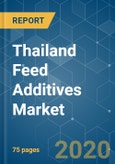The Thail feed additives market is projected to reach USD 2.56 billion by 2025, with a CAGR of 5.0%, during the forecast period. The drivers identified in this market are the growth of the poultry market in Thailand and growth in the compound feed industry. The restraints identified in the market are government regulations on food safety and the increasing cost of raw materials.
Key Market Trends
Growth in the Compound Feed Industry is Driving the Market
The Thai animal feed industry is growing at a steady pace due to the increase in broiler production, which is driven by rising income, increasing population, higher diversified consumption, and wheat feed demand. The country’s per capita food consumption declines as the rising incomes support shifts from rice toward a more diversified diet with increased meat consumption, especially poultry. In 2017, Thailand imposed regulations that would require feed mills to purchase domestic corn before importing feed wheat at a 3:1 domestic absorption rate of imported feed wheat/domestic corn, resulting in a significant reduction in the Thai feed wheat imports.
Rapidly Growing Feed Antibiotics Market
The feed binder market has been segmented into synthetic and natural feed binders by type. Wheat, guar, meal, starch, lignin, bentonite, clay, specialty hydrocolloids, gums, etc., form the ingredients for natural binders. Urea-formaldehyde and polymethylocarbamide are vital ingredients for synthetic binders. Good quality pellets are difficult to produce with corn and soy, which are the main ingredients in many feeds (such as those for swine, requiring the use of binders). As chemical-free pasture has to cater to consumer preference for organic meat, natural binders are increasingly being preferred over synthetic binders over the past few years. Owing to the enhanced feed conversion ratio in these animals (due to increased performance, improved immunity system, and increased body weight gain, with the incorporation of feed binders), the feed binders sector is growing in the Thai region.
Competitive Landscape
There are many international, as well as local, companies in the Thai feed additive market, which are adopting various strategies, like expansions, partnerships, and new developments, to increase their market presence in the country. Cargill recently acquired a feed mill in Prachinburi province in Thailand to expand its animal feed and nutrition business capabilities. The acquisition enables the company to produce poultry and wine feed for its Thailand customer base.
Reasons to Purchase this report:
Key Market Trends
Growth in the Compound Feed Industry is Driving the Market
The Thai animal feed industry is growing at a steady pace due to the increase in broiler production, which is driven by rising income, increasing population, higher diversified consumption, and wheat feed demand. The country’s per capita food consumption declines as the rising incomes support shifts from rice toward a more diversified diet with increased meat consumption, especially poultry. In 2017, Thailand imposed regulations that would require feed mills to purchase domestic corn before importing feed wheat at a 3:1 domestic absorption rate of imported feed wheat/domestic corn, resulting in a significant reduction in the Thai feed wheat imports.
Rapidly Growing Feed Antibiotics Market
The feed binder market has been segmented into synthetic and natural feed binders by type. Wheat, guar, meal, starch, lignin, bentonite, clay, specialty hydrocolloids, gums, etc., form the ingredients for natural binders. Urea-formaldehyde and polymethylocarbamide are vital ingredients for synthetic binders. Good quality pellets are difficult to produce with corn and soy, which are the main ingredients in many feeds (such as those for swine, requiring the use of binders). As chemical-free pasture has to cater to consumer preference for organic meat, natural binders are increasingly being preferred over synthetic binders over the past few years. Owing to the enhanced feed conversion ratio in these animals (due to increased performance, improved immunity system, and increased body weight gain, with the incorporation of feed binders), the feed binders sector is growing in the Thai region.
Competitive Landscape
There are many international, as well as local, companies in the Thai feed additive market, which are adopting various strategies, like expansions, partnerships, and new developments, to increase their market presence in the country. Cargill recently acquired a feed mill in Prachinburi province in Thailand to expand its animal feed and nutrition business capabilities. The acquisition enables the company to produce poultry and wine feed for its Thailand customer base.
Reasons to Purchase this report:
- The market estimate (ME) sheet in Excel format
- 3 months of analyst support
Table of Contents
1 INTRODUCTION
4 MARKET DYNAMICS
5 MARKET SEGMENTATION
6 COMPETITIVE LANDSCAPE
Companies Mentioned (Partial List)
A selection of companies mentioned in this report includes, but is not limited to:
- Nutriad Asia Pacific
- Adisseo Trading (Thailand) Co. Ltd
- BASF (Thai) Limited
- Danisco Animal Nutrition
- Alltech Thailand
- ADM (Thailand) Ltd
- Cargill Siam Limited
- DSM Nutritional Products (Thailand) Ltd
- Kemin Industries Inc.
- Charoen Pokphand Group
- Eurotec Nutrition Group
Methodology

LOADING...








